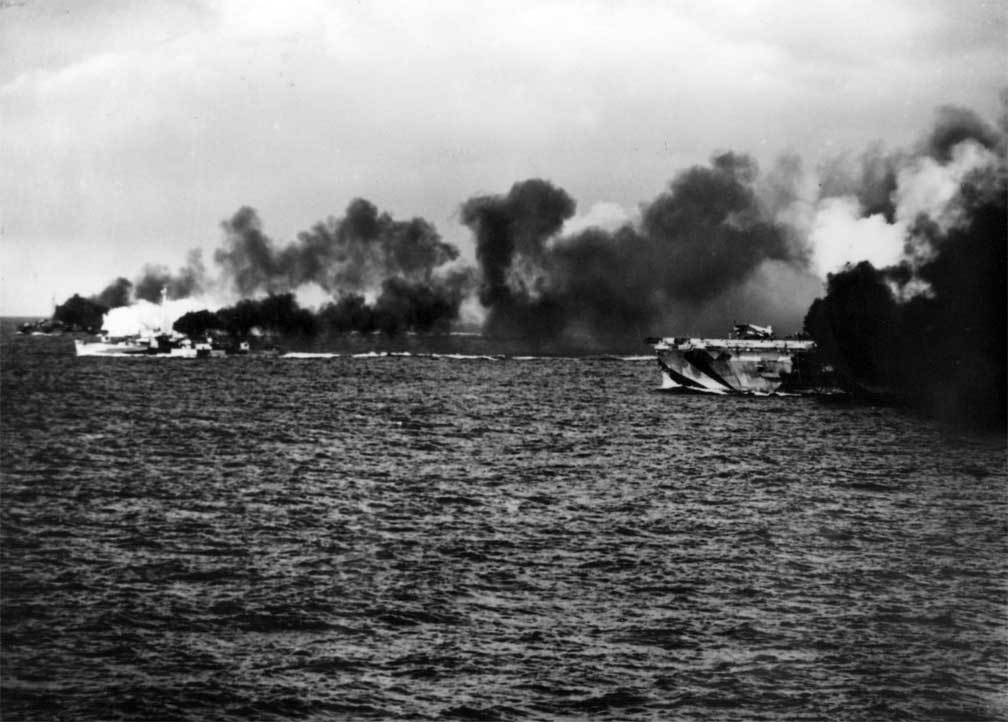OCTOBER 25th 1944
Battle Of Leyte-Samar

Escort Carrier USS Gambier Bay, Destroyer Escort USS Raymond, and another Destroyer Escort, elements of Taffy 3, laying smoke before engaging the Japanese Center Force in the Battle Off Samar, Oct 25, 1944.
The second stage of the battle occurred when a Japanese force led by Admiral Kurita of battleships and cruisers came upon a force of escort carriers of Task Force Tafy 3 commanded by Rear Admiral AF Sprague, off Samar. The escort carriers were hit repeatedly by the guns of the Japanese force. However, daring attacks by three American destroyers, as well as desperate attacks by all of the carriers’ planes, succeeded in driving off the superior Japanese force. The Americans lost only the escort carriers Gambier Bay and St Lo. Two destroyers and a destroyer escort that had gallantly attacked the Japanese battleships were also lost. The invasion fleet, however, was safe. The final act in the battle occurred when US aircraft attacked the Northern Japanese force. Three Japanese carriers were sunk as well as a cruiser and destroyer. Most of the remaining vessels were heavily damaged.The Battle of Samar was one of the most peculiar battles of the war. American commanders, following the Battle of Surigao Straits, believed that the Japanese no longer posed a substantial threat and had vacated the Surigao Straits. A Japanese force, commanded by Admiral Kurita, consisted of four battleships, eight cruisers, and eleven destroyers. This force successfully maneuvered undetected through the area.
The formidable US naval force, known as the Third Fleet, comprised numerous fleet carriers and six fast battleships, along with their accompanying cruisers and destroyers. The Third Fleet had been drawn north in pursuit of the Japanese aircraft carriers, which had been employed as a decoy. However, the Japanese fleet lacked sufficient experienced aviators to effectively utilize its carriers.
Meanwhile, a force of six escort carriers and destroyers, accompanied by escorts, was stationed in Leyte Bay to provide support for the ground troops. This squadron was commanded by Rear Admiral Sprague.
The Japanese column managed to approach the American force, designated as Taffy 3, within a distance of 20 miles before being detected. The Japanese, believing they had stumbled upon the main American battle force, promptly commenced firing their long-range battleship turrets. Geysers of water erupted around the American vessels. The largely unarmored American force was ill-equipped to confront a large Japanese battle fleet. Sprague attempted to maneuver his force out of the vicinity, while simultaneously ordering his destroyers to engage with their torpedoes.
The three destroyers, the Hoel, Heermann, and Johnston, valiantly attacked the larger Japanese ships. The Johnston successfully struck a torpedo onto the Japanese heavy cruiser Kumano, rendering it disabled. The other ships fought with great courage, gaining valuable time for the escort carrier. Consequently, the Japanese ships were compelled to alter their course to avoid the attacks.
After the destroyers were sunk by the Japanese, the even smaller destroyer escorts were ordered to engage. They fought against overwhelming odds. The commander of the Samuel B. Roberts, which was subsequently sunk, recorded the following account:
Witnessing the conduct of the average enlisted man on board this vessel, with an average of less than one year’s service, would make any man proud to be an American. The crew was informed over the loudspeaker system at the commencement of the action of the commanding officer’s estimation of the situation: a fight against overwhelming odds from which survival could not be anticipated, during which time we would inflict as much damage as possible. In the face of this knowledge, the men zealously named their stations and fought and worked with such calmness, courage, and efficiency that no higher honor could be conceived than to command such a group.
Meanwhile, Taffy 3 ordered all of its planes in the air and to attack the Japanese ships, regardless of their armor. An SOS was sent to all the other Allied ships in the area. While the fleet carriers were too far away to assist Taffy 1 and Taffy 2, which consisted of escort carriers, were close enough. In total, the US Navy had 235 fighter planes and 143 torpedo aircraft to confront the Japanese. The planes were not equipped with the appropriate ammunition, and pilots had primarily been trained for anti-submarine warfare. However, they persisted in attacking the Japanese ships with whatever resources they possessed.
Between the air attacks and the destroyer attacks, the attacking Japanese ships had sustained damage. Three heavy cruisers were sunk, but before Kurita decided to withdraw, they had drawn within 10 miles of the American escort ships and were firing a steady stream of shells at them. The escort carrier responded with their own 5-inch guns. The relentless barrage of shells was sufficient to sink two of the escort carriers: the Gambier Bay and the St. Lo. However, the rest survived. The Japanese never came close to the transports, which were still unloading, and the Karita’s force returned to Japan, never to engage in battle again. This victory was costly, with 1,130 Americans killed or listed as missing in action and 913 wounded.
The final phase of the Battle of Leyte was the Battle of Cape Engano, where the United States Task Force 34 encountered the Japanese carriers. The American force consisted of ten fleet carriers. For an entire day, the American forces engaged the Japanese force, which had limited air support. Approximately 527 sorties were employed to sink the Japanese fleet carrier Zuikaku, the light carriers Chitose and Zuihō, and the destroyer Akizuki. Additionally, the light carrier Chiyoda and the cruiser Tama sustained significant damage. The remaining Japanese forces were forced to retreat to Japan.
 >
>